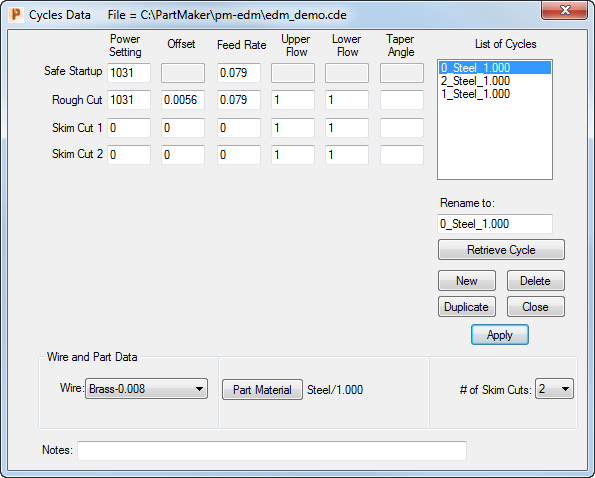Use the Cycles Data dialog to combine a series of roughing and finishing operations into a single entity, called a Cycle. All the cycles are saved in a Cycles Database file (.cdb), so you can reuse them again when required. The name of the current Cycles file is displayed in the dialog's title bar.

To display the Cycles Data dialog, select ToolMinder > Cycles.
The following settings are available:
Power Setting — The power setting required.
Offset — The distance between the center of the wire and a part.
Feed Rate — The wire feed rate.
Upper Flow — The coolant flow rate for the upper guide.
Lower Flow — The coolant flow rate for the lower guide.
Taper Angle — The taper angle of the wire for the operation. All Taper Angle fields are empty by default so PartMaker uses the Taper Angle specified in the Profile Element Data dialog. If you specify a value in this field, it overrides the value specified in the Profile Element Data dialog.
List of Cycles — Lists all of the cycles currently stored in the Cycles database.
Rename to — The name of the currently selected cycle.
New — Click to create a new (empty) cycle.
Delete — Click to delete the currently selected cycle.
Duplicate — Click to create a duplicate of the currently selected cycle.
Apply — Click to save any changes you have made to the Cycles Data dialog.
Close — Click to close the Cycles Data dialog.
Retrieve Cycle — If you have a pre-existing library of cycles that is specific to your machine, you can retrieve cycles from this file by clicking the Retrieve Cycle button and add them to the current Cycles database. Clicking this button displays the Wire and Part Data(WPD) dialog where you can specify details of the cycle(s) you want to retrieve.
Wire and Part Data:
Wire — Select the wire (from the Tools database) to be used for the current cycle.
Part Material — Click to display the Select Material dialog, where you can select the material to be used.
# of Skim Cuts — Select the number of skim cuts in the cycle.
Notes — Enter any notes for this cycle.